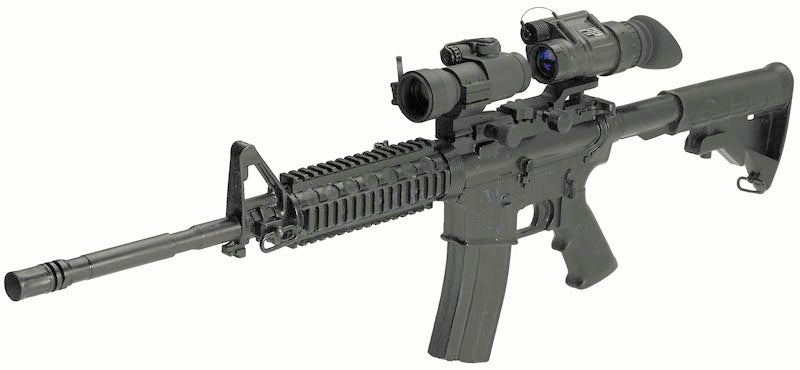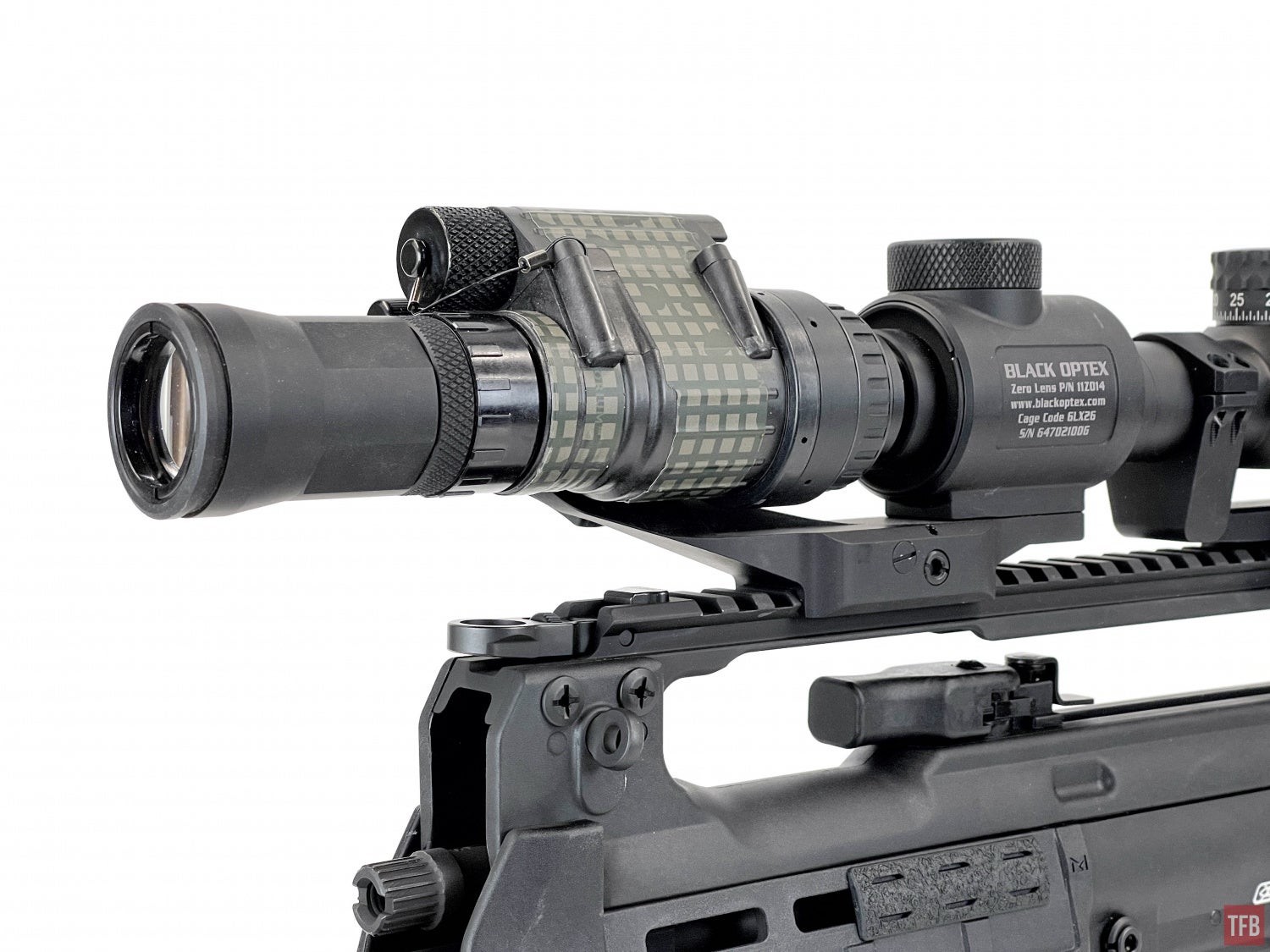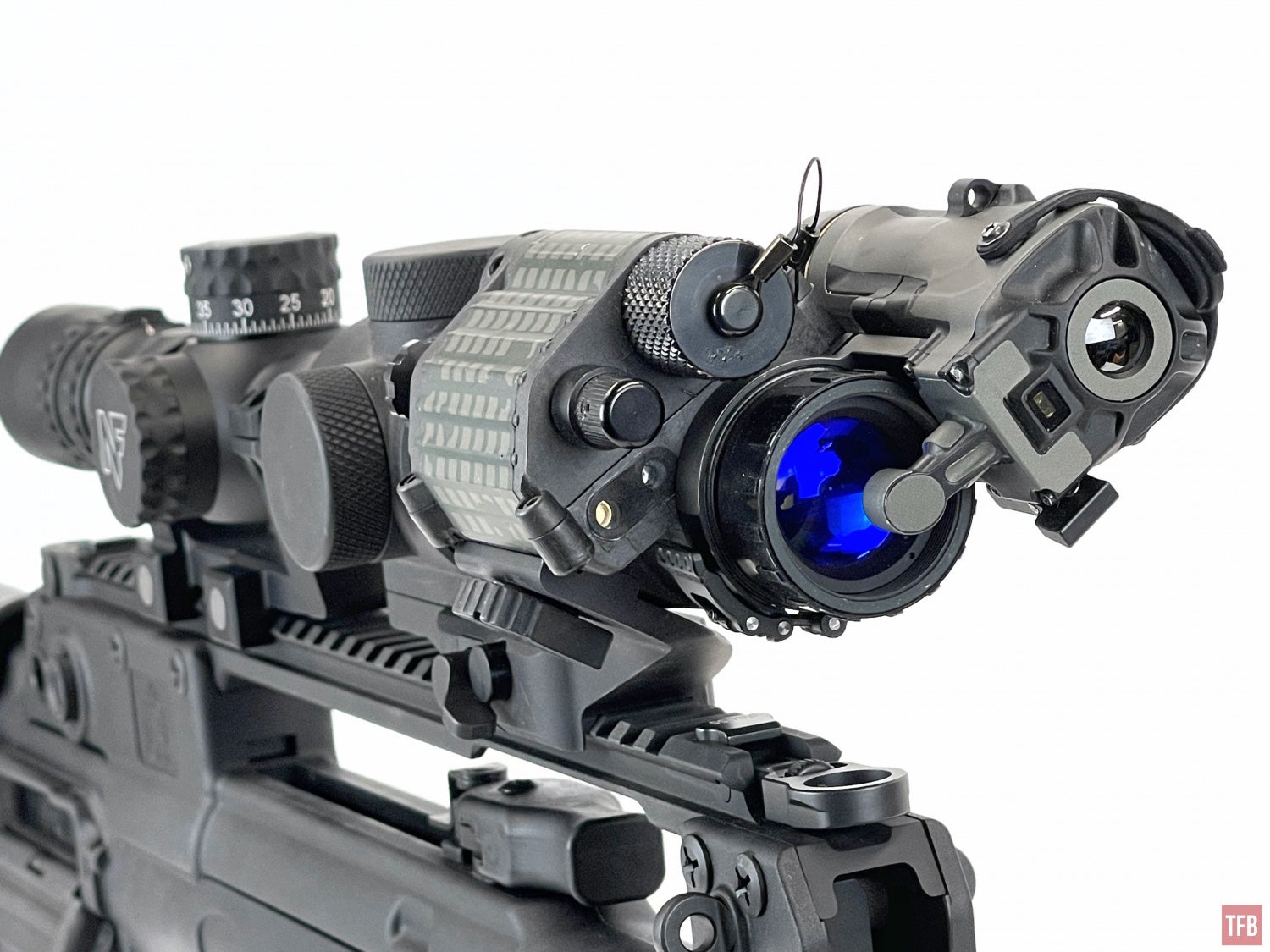Welcome back to another installment of Friday Night Lights where I review things that help you see at night. Today we take a look at a somewhat obscure accessory by Black Optex called the Zero Lens. It converts a PVS-14 into a CNVD (Clip-on Night Vision Device). Allowing you to take further shots with a day optic on your rifle of choice.
CNVD @TFB:
- Friday Night Lights: NVD KAC UNS®SR Night Vision Clip-On
- Friday Night Lights: Simrad KN203 Clip-On Night Vision
- Friday Night Lights: Magnum Universal Night Sight (MUNS) PVS-27
Weapon Mounted PVS-14 – Not A Good Idea?
There are a number of ways to mount a PVS-14 to a gun. The most common method is the USGI MIL-SPEC weapon mount. It is a simple Picatinny mount that screws into the mounting hole on the PVS-14.

You then mount it behind a red dot and now you can aim and see in the dark.

Even though the USGI MIL-SPEC weapon mount exists, it is universally not a good idea to use this. Helmet mounting a PVS-14 with 1x magnification is the better way to go. This way you do not have to point a gun just to see in the dark. Another issue is having the PVS-14 looking through your red dot for extended periods of time. With constant exposure of the phosphor screen from your red dot, you can burn that reticle into your tube. Somewhat like old CRT computer monitors. If you keep the image changing in the PVS-14, the image cannot be burned into the tube. Powerful lasers and staring into the sun will damage the tube but that is a different issue. Another issue with weapon mounting a PVS-14 is the fact that the PVS-14 and the image intensifier inside are not recoil rated. Many experts say a PVS-14 can handle recoil on an AR-15 chambered in 5.56. But heavier recoiling guns like a .308 could cause recoil damage to the tube.
So What Can You Do?
One way to mitigate the recoil problem is to get a recoil-rated image intensifier. Cody B. sent these photos to me. There are some image intensifiers that are better suited for recoil. These tubes are used in actual night vision clip-ons. There is more involved inside a night vision clip-on like setting the tube in the housing with RTV silicone or something similar. But to use these types of tubes in a PVS-14 will work for some guns like a .308. It won’t be recoil rated for a .50 BMG but better than an AR-15.

Photo by Cody B.

Photo by Cody B.
Well, that solves the recoil issue. What about the problem of staring into a red dot? Why not move the PVS-14 in front of the red dot or other day optics? Yeah, it doesn’t work, I’ve tried it. The problem is PVS-14s are not collimated like a proper night vision clip-on. So you will have a massive POA shift. Another big problem is you are staring into the eyepiece of a PVS-14. It is not designed to be looked at with a magnified optic and it does not work when the PVS-14 is too far away from your face. Like if you have a red dot between your eye and PVS-14. But Black Optex has a solution for this, their Zero Lens.
Black Optex Zero Lens Transforms Your PVS-14

The Zero Lens is a mount for a PVS-14 with a lens that sits behind the PVS-14. It comes with a small 3x magnifier that you screw onto the objective lens. I posted about this small magnifier in my article about night vision magnifiers.

The mount is canted to position the eyepiece in front of the Zero Lens.


The tabs in the front and back cradle a specific part of the PVS-14 and this is a minor issue. Black Optex designed this mount for use on US MIL-SPEC PVS-14 housings. Other PVS-14 housings are slightly out of spec and do not fit. See the photos below. The front tab is not far enough for the PVS-14 to sit flat.


Now here is a Carson Industries PVS-14 housing and it does sit flat in the Black Optex Zero Lens.


The screw and triangular protrusion are pretty standard but the tabs that stick up are unique to the Zero Lens. No other PVS-14 mount uses this design. It is extremely limiting. I have tried other monoculars like my AB Night Vision ANVIS and MOD3. Unfortunately, that part that interfaces with the Zero Lens is not compatible.
Going back to the Zero Lens 3x magnifier. You need this to make the night vision image look normal. Without the magnifier, the image will appear smaller than 1x in your scope.


The downside to the Zero Lens magnifier is that it is so small and does not let in as much light as the mil-spec 3x magnifier. See the photo below.

The mil-spec magnifier is so much bigger than the Zero Lens magnifier.


But wait Nick, you said you can’t put a PVS-14 in front of an optic?
Yes, you can’t do that. But the Zero Lens has a lens that sits behind the PVS-14. It is like a 3x magnifier but flipped around 180º. So rather than making the image look bigger, it makes the image look smaller. This is the reason you need the included magnifier in the front.

The crucial part of the Black Optex Zero Lens is the fact that the reverse magnifier has windage and elevation adjustments. Now you can zero the image to your scope.

The simplest way to do this is to zero a laser to your day optic at your desired distance. 100 yards is a good place to do this or 50 yards for an AR-15 in 5.56. With the laser set to a converging zero, mount the Black Optex Zero Lens. You will notice a POA shift and the laser will appear to not be zeroed to your scope. This is why directly mounting a PVS-14 in front of a day optic does not work. But with the Black Optex Zero Lens, you can adjust the image with the windage and elevation knobs. Turn them so the image of the laser matches your scope at the distance you zeroed them originally.
Looking Through The Zero Lens

If you remove the 3X magnifier from the front this is what the image looks like.

I am using my Bushnell LMSS spotting scope and it starts at 8x magnification. When setting up the Zero Lens, you need to adjust a lot of lenses to get the best possible image. You need to adjust the focus of the PVS-14 objective lens. For some reason, adding a 3x magnifier changes the focus. So while your PVS-14 might have been set to infinite focus without the 3x magnifier, adding the magnifier will cause you to adjust the focus for clarity at infinity. You may also need to adjust the diopter to clear up the image going into your day optic.


With the 3x magnifier installed on the objective lens. 8x magnification on the spotting scope.

15x seems to be the most you can zoom into the Black Optex Zero Lens and have some sort of image that you can discern some details. See below.

I tried the Black Optex with a Meopta 1-6 LPVO. Oddly, at 1x the image looks small. I found 2x was the bare minimum magnification to have a decent night vision image.

LPVO on 1x looking through Zero Lens.

2x on the LPVO.
Unfortunately, at 6x magnification on the LPVO, the night vision image is unusable.

Why is this the case when 8x on the spotting scope looked better than this? The spotting scope has a rear diopter and you can adjust the focus to sharpen the image coming from the Black Optex Zero Lens. The LPVO I have does not have a parallax adjustment and it does not have the ability to focus the objective lens.
Here is a video I recorded a while back when there was no moon. You can see how poorly the Zero Lens performs.
Hacking The Zero Lens

Since the Zero Lens uses a PVS-14, you can skip the 3X magnifier for thermal fusion. I mounted my Infiray Jerry C to the PVS-14.

It is not the best of thermal images but you can detect heat while looking through night vision.



Final Thoughts On The Zero Lens
The Black Optex Zero Lens can be purchased for around $1,000 from Browe Inc. That is where I ordered mine. I found a used one for less that I tried to modify, I removed those ears so I could try and mount other monoculars but it was too easy for the monocular to rotate and not stay straight. The 3x magnifier is not great but you can get a mil-spec magnifier for not that much and have better performance. The Zero Lens was actually designed and manufactured by Torrey Pines.
I found the Zero Lens works ok in bright ambient light like full moon. But in darker nights like moon-less nights, it really struggles compared to dedicated clip-ons like the PVS-30 and PVS-27. The biggest problem is that you are limited by your PVS-14 housing and the image intensifier inside. More than likely it is not recoil rated and so this limits what guns you can use the Zero Lens on. I would not want to risk damaging my PVS-14 on anything greater than a 5.56 AR-15, since I know none of my tubes are recoil rated.
If you want to shoot far at night, save up and get a good clip-on. If you want to dabble and shoot maybe 400 yards under ideal conditions with an AR or a .22LR bolt gun then the Zero Lens may be an option.
 Your Privacy Choices
Your Privacy Choices
